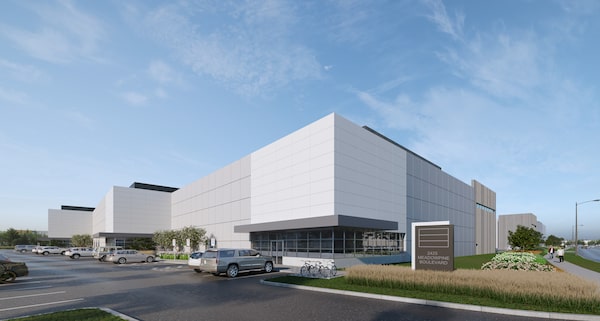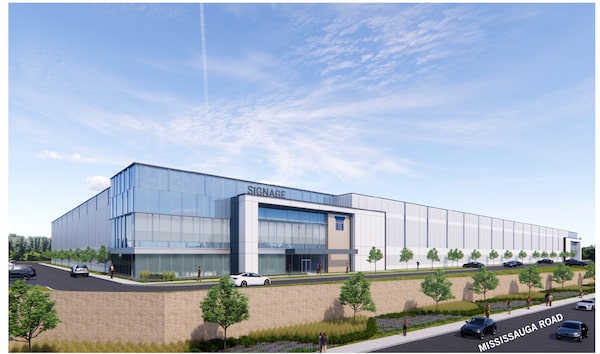
A rendering of an industrial building in Mississauga that will replace Roche Canada offices. Dean Cutting, managing partner at Carttera, which owns the site, says the demand for industrial space is “insatiable.”Courtesy of Carttera
With more people working from home and companies scrambling to keep their supply chains running, some developers are taking a second look at office buildings and replacing them with industrial space.
In Mississauga, for example, an 11.3-acre (4.57-hectare) site once occupied by pharmaceutical giant Roche Canada (formerly Hoffman-LaRoche) illustrates the story of the tilt away from offices toward manufacturing and warehousing space.
Carttera Private Equities Inc., which now owns the property, is ripping down an office building with 115,000 square feet of space on the site and redeveloping the entire property into two industrial buildings with a total of 248,000 square feet. Carttera purchased the site in late 2020 for $24-million.
“It’s one of 20 projects we have on the go in the Greater Toronto Area and Montreal, together worth about $3-billion,” says Heidi Tibben, partner, asset management at Carttera. “They’re not all industrial but a lot of them are.”
The Mississauga site, near Highways 401 and 407 and Toronto Pearson International Airport, makes more sense as industrial space, says Dean Cutting, managing partner at Carttera. It’s not that there was anything wrong with the office building, he explains, but there is now “an insatiable demand” for industrial.
The replacement of office buildings, particularly suburban ones, is a trend in larger regions such as the GTA, says Victor Cotic, senior vice-president of national investment services at Colliers Canada. There have been several such redevelopments in the GTA in the past two years.
“It’s the first time I recall this happening in my 15 years in the business,” Mr. Cotic says.
There are several reasons for the trend, says Allan Perez, chief executive officer at Toronto-based CanFirst Capital Management, which is developing another Mississauga site, converting 14.1 acres it purchased last October for $49-million. CanFirst plans to take down a two-storey office building and turn the site into industrial and logistics space.
“The first reason is that there is a lot of suburban office space that has probably outlived its useful life, and of course people are not going into the office as often these days,” Mr. Perez says.
As a result, vacancy rates for office space have increased, though they will likely decrease somewhat as people return to offices whenever the pandemic wanes, he says, adding “there’s still going to be a significant overhang of vacant office space.”
The explosive growth in the logistics sector as e-commerce becomes more popular is another factor.
“This growth was already on the upswing before the pandemic began,” he says. “[I understand] that in 2020 alone, the growth in e-commerce globally was equal to its growth in the previous 10 years combined.”

CanFirst Capital Management plans to take down a two-storey office building and turn the Meadowvale Court site into industrial and logistics space.courtesy of CanFirst
Companies catering to e-commerce need space to keep inventories near enough to reach customers within a few hours or days, and have little use for floors of cubicles and meeting and presentation rooms.
“Industrial buildings are now selling for more on a per-square-foot basis than suburban office buildings,” Mr. Cotic says. “Ten years ago, the best-in-class industrial building in a suburban area would sell for around $100 per square foot; now it’s in excess of $300.
“Meanwhile, suburban office buildings were selling for around $250 per square foot 10 years ago, and now they’re selling for $200 to $250. That’s why investors are saying, ‘If I buy a vacant office building, I’ll tear it down,’” he adds.
Colliers Canada’s National Market Snapshot of office and industrial property for the last quarter of 2021, which projects into this year, found that the national vacancy rate for suburban office space was at 12.1 per cent during the fall, and increasing. Industrial space, on the other hand, had a 1.3-per-cent vacancy rate, which was still shrinking in the last quarter.
Average net rents per square foot for suburban office space were still higher than for industrial properties, but the office rates were dropping, and the industrial ones were climbing, the report said.
Retailers will likely continue to look for industrial sites with good transportation access, the report added, because they need to have products on hand to deliver to customers. It’s a “just-in-case” inventory strategy that is “expected to drive demand for industrial over the foreseeable future,” the Colliers snapshot said.
According to Chuck Scott, chief executive officer of Cushman & Wakefield, Canada, e-commerce will continue to push the growth of industrial real estate space in Canada this year. The space is needed, he says, because “buy online, pick up in store” shopping has grown in Canada by nearly 50 per cent since the pandemic began, and retailers need warehouses nearby to obtain goods on short notice for customers.
It’s cheaper to keep large inventories in warehouses rather than in expensive real estate, and shoppers increasingly go to stores now just to look at and compare goods, Mr. Perez says.
“They want the experience and sales advice and then they go home and order online,” he says. “The industrial space is needed so their orders will be ready.”
But the trend toward converting suburban office properties to industrial is not a sign that offices are history, Mr. Scott says.
“Going forward, the purpose of the office will be to provide inspiring destinations that strengthen cultural connection, learning, bonding with customers and colleagues and foster creativity, collaboration and innovation,” he says.
New office buildings in the end-of-pandemic era will be different though, Mr. Cutting adds. For example, a downtown Toronto office building Carttera is planning will have state-of-the-art ventilation and be built to ecofriendly standards for the low- and zero-carbon future.
“A lot of what we do is repurposing assets,” he explains. “But we’re not giving up on the office.”